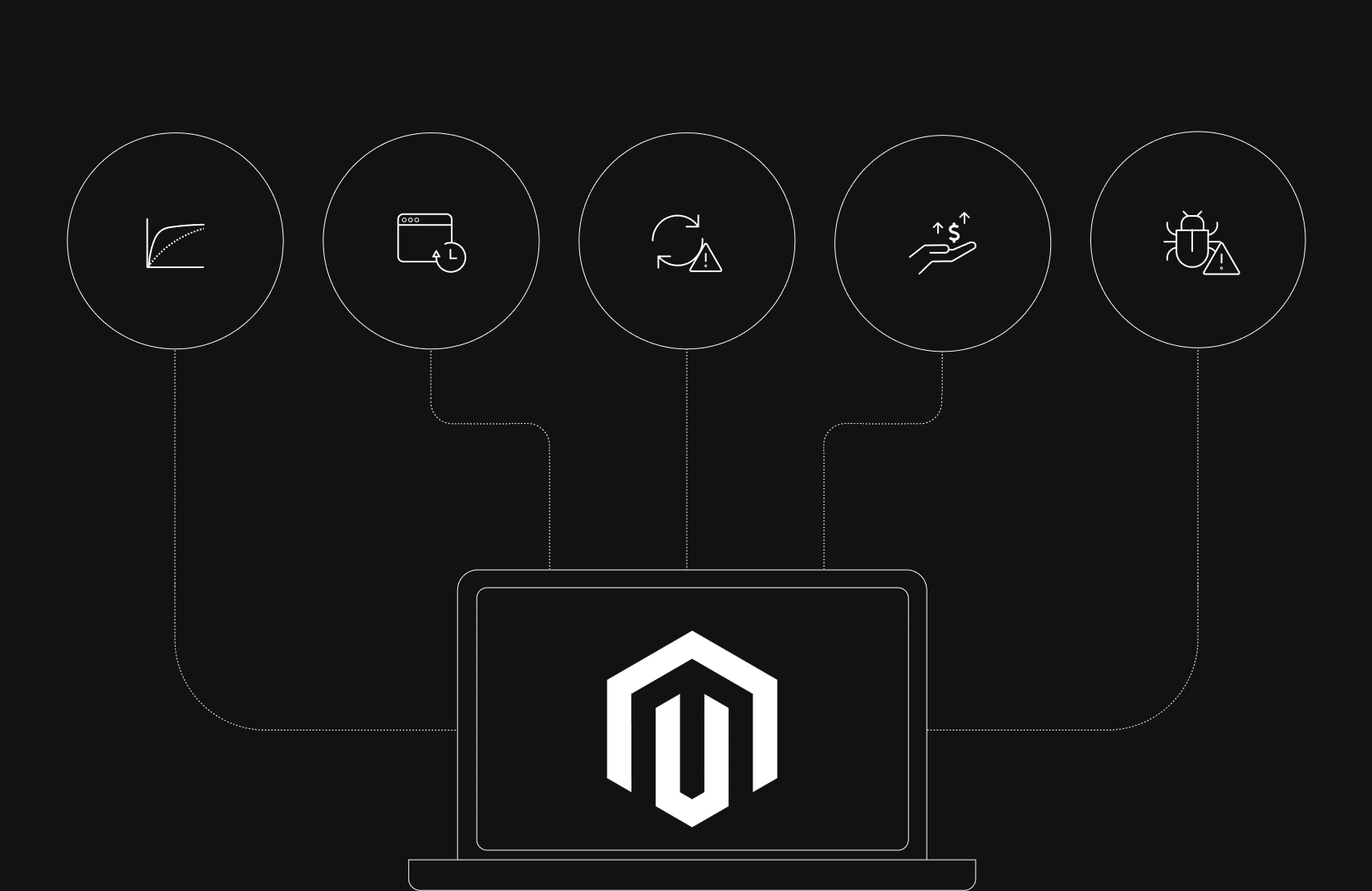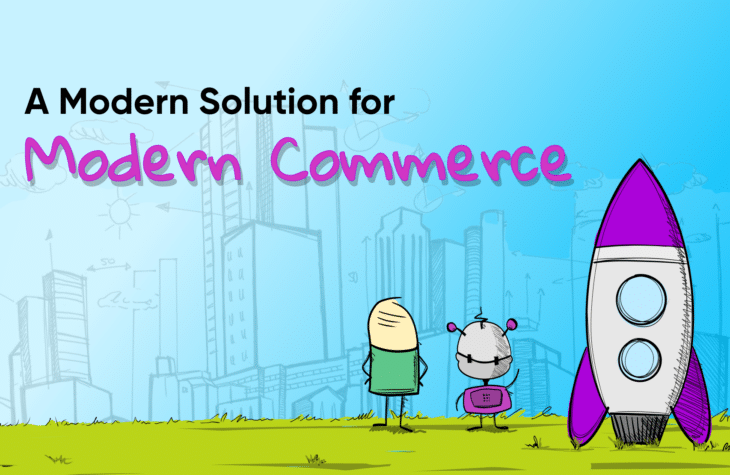5 Challenges for Magento E-Commerce Web Development

Magento is one of the most popular e-commerce platforms today. Businesses that want to create a custom shopping experience, a platform that grows with them, or a platform that provides many out-of-the-box features generally lean toward Magento, as it promises all that and more.
However, every developer who has learned and worked with Magento, including myself, can tell you a handful of reasons why it’s very challenging: It’s very hard to learn, has frequent quirky bugs and issues, and is very slow.
In this article, we’ll cover the features Magento offers to e-commerce developers. Then we’ll go over five challenges e-commerce developers face when working with Magento. In the end, we’ll take a look at Magento’s alternatives.
Overview of Magento
When an e-commerce manager or developer looks for different e-commerce frameworks and platforms to choose from, Magento is one of the first choices they find that fits many requirements.
Magento is an open source e-commerce platform released in 2008 that is built with PHP. Magento lets developers and business owners create a platform that grows with them as necessary. Adobe recently acquired Magento in 2018, and since then has made many improvements, most notably on Magento’s documentation.
Magento is a highly customizable e-commerce framework. When you need to add new features, you can create modules or themes that add to, modify, or override existing features. You have the ability to change the platform per your requirements.
However, in a lot of use cases, you won’t need to add new features. Magento comes with many features that most businesses find more than enough.
Furthermore, Magento has a huge community. As an open source platform, it has over 1,400 contributors that help resolve bugs and issues, as well as add enhancements to the platform. A huge part of Magento’s growth is the community that has contributed to it countless times.
Magento E-Commerce Development Challenges
This is the part that most developers and teams miss when they look for the right e-commerce platform and land on Magento. Although Magento has a lot of advantages, it comes with many other challenges that most developers, teams, and businesses discover when it’s too late.
Here’s a summary of the difficulties e-commerce developers face when using Magento:
| Challenge | Impact | Description |
|---|---|---|
| Steep learning curve | High | Its complex architecture makes it hard to find experienced Magento e-commerce developers. |
| Slow development and websites | High | Magento’s e-commerce web development workflow is slow, leading to a bad user experience. |
| Breaking updates | Medium | Magento occasionally has breaking minor patches. |
| Costly Resources | Medium | Magento’s resources, such as developers, hosting, and deployment, lead to a high “e-commerce tax”. |
| Lacking bug fixes | Low | Many bugs are labeled as “Cannot Reproduce.” |
1. Steep learning curve
In 2018, I was hired at a company for the sole purpose of learning Magento. Although I was a pretty skilled PHP developer back then, it was so hard to learn. I’ve been using it every day since then, and I still discover new quirks and unexpected errors or issues.
As I mentioned earlier, Magento’s documentation has improved since Adobe acquired it. However, it’s still not easy to learn because its architecture is complex.
Whether it’s something as simple as using Bootstrap in your theme (there are about 500 questions on Magento StackExchange just about that) or as complex as creating a module that customizes core functionalities or adds to them, everything in Magento is done the hard way.
Because it’s hard to learn, it’s hard to find expert Magento e-commerce developers. You’ll either have to hire someone to learn it and become an expert; hire experts that are not easy to find and, consequently, are costly; or rely on freelancer developers, which comes with its own set of problems.
I once was hired as a freelance developer to fix bugs and issues made by previous freelance developers. Thus, finding and hiring developers to do the job is definitely costly and one of the biggest challenges of using Magento.
2. Slow development and websites
This challenge deals directly with Magento e-commerce web development. Because of Magento’s complex architecture, two additional problems arise: 1. Slow development workflow and 2. slow e-commerce websites.
The slightest change you have to make might require you to compile the generated code or the static assets for the website—even if it’s something as simple as changing the background color of the page. To see it in action, you have to deploy the static content. That basically means compiling Less, CSS, JavaScript, or other frontend assets for the changes to appear on the website.
This process becomes more time-wasting as you add more modules and themes because Magento will need to compile all of them even if the change is in just one. This means that developers take longer to implement or release features in Magento compared to the time it would take in other platforms.
Furthermore, the frontend of your store is pretty slow. This leads to a bad user experience and, ultimately, a bad search engine optimization (SEO) and lower ranking on search engines.
To make your website faster, you can use some of Magento’s configurations, like bundling and minifying assets. However, you’ll most likely need to use additional tools and services, like Varnish and Redis for your website to actually be considerably fast.
3. Breaking updates
After almost every major or minor release, multiple patches are released to fix the issues these releases bring with them. What makes it worse is that a lot of these problems involve security issues.
If you take a look at Magento’s Security Center, you’ll find many patches and some for the same release version. This means that whenever Magento has a new release, you should be careful before updating your platform, as the update can introduce bugs and security issues into it. This also means that using Magento requires constant maintenance for unexpected changes and bugs.
4. Costly resources
The previous points have highlighted this issue quite a bit. Magento requires a lot of costly resources. From the developers, you need to hire (whether freelance or in-house) to the hosting, deployment, and maintenance, the costs pile up with time.
You’ll realize just how much you’ve put into Magento more and more as your business grows. You’ll need more experienced e-commerce developers, especially if you need complex features. You’ll need more cloud, storage, and hosting resources. The list of additional costs can heavily increase with time.
5. Lacking bug fixes
Again, this is another drawback of Magento’s complex system. Many bugs that might occur in your development or production environment could be hard to reproduce by Magento’s team of developers, which is why there are now 1,500-plus closed issues with the label “Cannot Reproduce” on GitHub.
Admittedly, a lot of these bugs and issues occur because of modules you find online or even create yourself. This is because a small change you make might affect something deep in the system that you don’t know about, and might even never find out about, or require a lot of debugging.
Hence, all these factors mean that although Magento has a strong community that supports it in solving bugs and issues, some bugs might not get a fix, and you’ll have to figure out a way to resolve them on your own.
Magento Alternatives
Magento’s many challenges all go back to its complex architecture. The system is tightly coupled and advanced in a way that makes it hard to learn, causes issues when you try to modify it, and slows down the platform and development process.
A better alternative to Magento’s monolithic architecture is microservices-based commerce. Microservices-based commerce is the set of e-commerce services you can usually get from an e-commerce platform or framework, except they’re all independent. You can use them together or couple and integrate them with other external services.
The move from a large system with lots of features and services that are tightly knit to smaller modules or services that are independent of one another but can still work harmoniously together removes the complications and challenges that occur in platforms like Magento.
fabric is a platform that lets you do exactly that—providing a set of microservices that you can integrate as necessary. With fabric’s headless e-commerce APIs that provide the core functionalities of an e-commerce store through an API independent of the frontend, you have more flexibility in your platform.
You can easily make changes to the frontend and the look and feel of your store without worrying about what goes on under the hood. Similarly, you can add new services and integrations to the backend without it affecting the frontend of your store.
Key Takeaways
- Magento offers a lot of built-in features and is very extensible. However, Magento’s challenges often outweigh the advantages of using it.
- The 5 developer challenges for Magento e-commerce development include a steep learning curve, slow website development, breaking updates, high costs, and the lack of bug fixes.
- Microservices-based commerce is the better alternative for monolithic platforms like Magento.
- With fabric, you get the same advantages you would need from Magento, including its extensibility and wide set of features, but with fewer e-commerce developer challenges.

Tech advocate and writer @ fabric.






